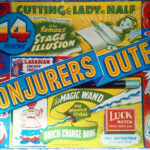Gothic Mash-Ups: Hybridity, Appropriation, and Intertextuality in Gothic Storytelling edited by Natalie Neill is now available from Lexington books. The book ‘explores the role of intertextuality in Gothic storytelling through the analysis of texts from diverse periods and media’.
It also includes my chapter Mashing up Magick: Bizarre Magick and the Fuzzy Gothic and here’s a tiny sneak peak …
Before moving on to discuss examples of the mashed-up Gothic in bizarre magick, it is important to acknowledge that magicians, in the creation of their act, their persona, and the workings of their effects, have always been experts in mash-up. Thus, while Simon During states that the “magic assemblage” may have popularized “new technologies and new sorts of pleasures” (During 2002, 1), it is important to remember that this form of entertainment ultimately was, and still is, the most deceptive form of showbusiness. Equally, there is a tacit acceptance of this deception in an audience; as James W. Cook quotes P.T. Barnum: “the public appears to be disposed to be amused even when they are conscious of being deceived” (Cook 2001, 16). Therefore, historically, many of the new technologies and new pleasures that were performed were carefully crafted falsehoods aimed at using mashed-up sources to create further falsehoods. So, while the father of modern conjuring Jean Robert-Houdin’s “Ethereal Suspension” claimed to reveal the hitherto unknown properties of the newly discovered ether, it was in fact a magic trick using mashed-up tropes from popular science with appropriated themes drawn from the popular ‘illustrated lecture’ model. Chung Ling Soo, the world-famous Chinese magician remembered today for being fatally wounded when his bullet-catch effect failed, was in reality American magician William Robinson (1861-1918). Robinson mashed-up notions of the Mystic East in order to pull off his “glorious deception” (Steinmeyer 2005) and present a performance persona of the kind identified previously by John Nevil Maskylne as “oriental jugglery” (Weatherly and Maskelyne 1891, 153). Equally, as Michael Mangan says of Houdini, perhaps one of the most famous characters in performance magic: “Houdini made up his own legends, weaving together fact and fantasy to create an illusory figure who became in many ways more real than the historical Ehrich Wiess who first invented him” (Mangan 2007, 140). Without laboring the point too much here, magicians have throughout history relied on mashing-up many sources to produce credible archetypes for both their persona and their act, whether this be the scientist, the oriental, the handcuff king, or something else. These apparent truths, having been mashed-up freely from a plethora of often disparate sources, ultimately form the core of a deceit which has allowed the magician to make their magic and pull off their deceptions.
Taylor, N. (2022). Mashing up Magick: Bizarre Magick and the Fuzzy Gothic. In N. Neill (Ed.), Gothic Mash-Ups: Hybridity, Appropriation, and Intertextuality in Gothic Storytelling (pp. 189–204). Lexington Books.
Cook, James W. 2001. The Arts of Deception: Playing with Fraud in the Age of Barnum. Harvard University Press.
During, Simon. 2002. Modern Enchantments: The Cultural Power of Secular Magic. Cambridge Mass.: Harvard University Press.
Mangan, Michael. 2007. Performing Dark Arts - A Cultural History of Conjuring. Bristol: Intellect Books.
Steinmeyer, Jim. 2005. The Glorious Deception. New York: Carroll & Graf.
Weatherly, Lionel, and John Nevil Maskelyne. 1891. The Supernatural? Bristol: J W Arrowsmith.


Comments by Nik Taylor